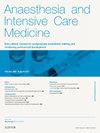Characteristics of special circulations
IF 0.2
Q4 ANESTHESIOLOGY
引用次数: 0
Abstract
Blood flow through a vascular bed is usually determined by the pressure gradient across it and the diameter of the precapillary resistance vessels. Special circulations have additional specific features of blood flow control. Several organs control their blood supply by autoregulation. Coronary blood flow is linked to myocardial oxygen consumption, primarily by a metabolic mechanism. Increases in demand or decreases in supply of oxygen cause the release of vasodilator metabolites, which act on vascular smooth muscle to cause vessel relaxation and hence increase blood flow. Cerebral blood flow is primarily regulated by a myogenic mechanism whereby increases in transmural pressure stretch the vascular smooth muscle, which responds by contracting. Renal blood flow is regulated by both extrinsic and intrinsic mechanisms; sympathetic vasoconstriction of the afferent arterioles reduces renal blood flow in response to a decrease in effective circulating volume, myogenic mechanisms and tubuloglomerular feedback, as well as the release of vasoactive metabolites from the vascular endothelium regulate renal blood flow intrinsically. Hepatic blood flow is delivered via the portal vein and hepatic artery, and the amount of flow varies in these vessels reciprocally to maintain constant total blood flow. The pulmonary circulation receives the entire cardiac output, and blood flow is regulated both passively and actively. Pulmonary vessels are highly distensible and can accommodate increases in blood flow without significant increases in pressure.
求助全文
约1分钟内获得全文
求助全文
来源期刊

Anaesthesia and Intensive Care Medicine
ANESTHESIOLOGY-
CiteScore
0.50
自引率
0.00%
发文量
152
期刊介绍:
Anaesthesia and Intensive Care Medicine, an invaluable source of up-to-date information, with the curriculum of both the Primary and Final FRCA examinations covered over a three-year cycle. Published monthly this ever-updating text book will be an invaluable source for both trainee and experienced anaesthetists. The enthusiastic editorial board, under the guidance of two eminent and experienced series editors, ensures Anaesthesia and Intensive Care Medicine covers all the key topics in a comprehensive and authoritative manner. Articles now include learning objectives and eash issue features MCQs, facilitating self-directed learning and enabling readers at all levels to test their knowledge. Each issue is divided between basic scientific and clinical sections. The basic science articles include anatomy, physiology, pharmacology, physics and clinical measurement, while the clinical sections cover anaesthetic agents and techniques, assessment and perioperative management. Further sections cover audit, trials, statistics, ethical and legal medicine, and the management of acute and chronic pain.
 求助内容:
求助内容: 应助结果提醒方式:
应助结果提醒方式:


